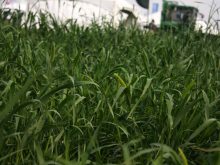An undesignated DNA in CDC Copeland has been traced back to the original breeder seed.
Earlier this year, the Canadian Malt Barley Technical Centre said grain companies had reported a higher number of malt barley samples than usual were not meeting the 95 percent purity minimum their contracts required. Most of these samples were Copeland.
CMBTC managing director Peter Watts said results from genetic tests on the original seed came in last week.
“It is Copeland,” he said.
Many malt barley customers are sensitive to purity standards and Watts said it is critical they know the variety has not been contaminated.
Read Also

U.S. bill could keep out Canadian truckers
The Protecting America’s Roads Act, which was tabled in the U.S. House of Representatives at the beginning of October, would “rid the country of illegal immigrant commercial truck drivers and ineligible foreign nationals.”
The Canadian Food Inspection Agency announced last week it would study the varietal purity of Copeland this growing season after high levels, more than five percent, of the undesignated DNA began appearing last fall.
Watts said this DNA is actually the third to appear in Copeland; the other two were detected and incorporated into genetic testing early in the variety’s existence.
This third DNA has been known since 2012, but was always at low levels.
“The real story is what environmental factor led it to propagate,” Watts said.
The high percentages of the DNA triggered the CFIA’s involvement, he said.
The CFIA said it would investigate whether there had been contamination but acknowledged that wasn’t likely because it has been present at low levels for a long time.
“Our findings so far suggest that the varietal purity issue that was identified by a DNA analysis may actually be part of the variety, as it was found in the earliest release of breeder seed,” the agency said May 5.
Doug Miller, executive director of the Canadian Seed Growers Association, said he first heard of this issue late last year.
He said seed growers appreciate that CFIA is conducting robust analysis. That gives farmers confidence in their seed, he said.
“Based on the information that we’ve seen to date, it does not appear that we are looking at a varietal contamination event but rather a variety that may have multiple genetic profiles all while maintaining a similar phenomic expression of how a plant looks in the field and the end-use traits and quality parameters,” he said.
Varietal purity is critical in programs such as malt barley and he said certified seed is the best choice for producers.
Canada’s certification system is based on phenotype and Miller said if the end use characteristics are the same and the plant looks the same, it meets the description of that variety.
CFIA did not return a request for more information before Western Producer deadlines but Miller said the agency may be using a framework similar to its variety verification program to follow up.
He described the program as one of the best kept secrets in Canada’s seed certification system.
“Every year they plant up to 2,000 plots of samples based on higher generation certified seed and they grow it out alongside the reference control sample, so what the breeder has submitted, and they basically walk the fields and it’s a health check on the system to make sure that seed certification is working correctly,” he explained.
Plot walkers identify any off-types that could signal other issues.
Miller said the exercise provides a vital health check on the seed certification system and is also part of some international obligations. New varieties are assessed against the reference control samples.
He and Watts both said malting analysis shows that Copeland with the high levels of the DNA performs nearly identically to Copeland with the lower levels.
“This is CFIA showing leadership and getting out there and doing an investigation whenever they hear concerns,” Miller added. “Everything that I’ve seen so far is indicating that the system is working.”


















